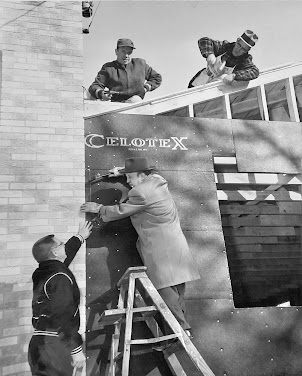After Fairfax voted to incorporate as a village, the community held its first election for village officials in July 1955. The newly-elected mayor and council had several priorities for the young village, such as police and fire protection, waste collection services, and street improvements with better lighting. However, the village government had no place to meet and no office space. The village’s elected officials were sworn into office at Fairfax School and continued to meet there until the end of 1955.
As the lease was nearing expiration, the landlord
notified the village there would be a significant increase in rent for a new
lease. Council began searching for another property to rent, but came up dry.
Mayor John Dinkel called an emergency meeting on a Saturday evening in late
November 1958 to discuss options. Someone suggested that the village build its
own municipal building. At 10:00 p.m., council unanimously approved the
suggestion.
By 10:00 a.m. the following morning, Mayor Dinkel turned
the first shovel for footings to support the structure. The temporary structure
was to be built to the south of the fire station on Germania. So, how could
construction begin so quickly? Well, our largely blue-collar community had a
number of residents with the necessary skills (and civic spirit) to build the
structure themselves on a volunteer basis. Village building inspector Ralph
Lucking, a carpenter in the construction industry, supervised the project and
drew up plans with councilmember William Pfeiffer.
The plumbing was installed by fire department captain and
professional plumber Art Beckler. Other firemen, including Frank Hochstuhl (an
electrician) and E.T. “Smokey” Whiteford (a painter) worked on the
project. Fairfax resident James Hodge
installed the heating system. 78-year-old Newton Hudson came out of retirement
to apply the sheeting. Mayor Dinkel, Police Chief Lonnie Auterson, Councilmembers Ronald Cribbet and Wayne Nichols, Assistant Fire Chief Jack
Roberts, village maintenance worker Bob Gordon, and Village Solicitor Paul
Weber were among those who helped. As many as two dozen volunteers worked on
the building at one time.
The 25 by 40 foot building was completed by January 1959
at a cost of approximately $3,100. Furniture was moved in just five weeks after
construction started. Mayor Dinkel said, "This isn't the end. This
building is only temporary. One of these days we hope to build a permanent
Village Hall to the north of the firehouse. . . . Some day we will have an
all-in-one home for our village business."
The temporary municipal building might not have been
quite as temporary as hoped. In 1966, Fairfax Village Council engaged an
architecture firm to submit plans for a new permanent municipal building. The
first proposal was to remodel the Berling Dairy building on Lonsdale at a
cost of $169,000. The second plan was to remodel the Berling Dairy garage
for $189,000. (The Berling Dairy garage later became the Recreation Center.)
The third proposal was to build a new one-story building on the site of the present
municipal building and demolish the Berling garage for $209,000. None of the
estimates included the purchase price for the Berling properties. Council chose
not to pursue any of these plans because they weren’t what they were looking
for and would cost more than they wanted to spend.
In 1970, the village hired a different architecture firm,
Pansiera, Dohme & Tilsey, to design a new municipal building. Ronald
Cribbet was mayor and councilmember Carrelton Williamson was chair of the building
committee. Initially, there was some community opposition to the project. Council invited residents to a meeting to review the plans.
Many came to the meeting to oppose the plan, but left satisfied when they
learned how the project would be financed without raising their taxes.
Construction of the new Fairfax Municipal Building was
completed in the spring of 1972. Features of the building included a 49-seat
council chamber, conference room, police department with two cells and a
darkroom, and offices for the mayor, clerk, treasurer, building inspector, and
fire chief. The entire building was air conditioned. The Cincinnati Post &
Times-Star reported that Fairfax may have had the first air conditioned
lock-up cells in the area and Police Chief Paul Ferrara had “misgivings about
making them unduly comfortable.”
The “permanent” Municipal Building has served the Village
of Fairfax for over 50 years now. However, I think I am prouder of the little white
frame “temporary” structure I remember from my childhood;
the one built with the volunteer labor of the residents of Fairfax.











No comments:
Post a Comment